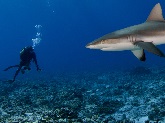- ABOUT US
- PROGRAM AREAS
- CONSERVATION APPROACH
- EDUCATION
- MULTIMEDIA
Snapshot of Coral Reef Health in the Pacific Region
NOAA Coral Reef Conservation Program releases status reports for Pacific U.S. states and territories

The NOAA Coral Reef Conservation Program has released status reports for coral reefs in the Pacific U.S. states and territories - American Samoa, the Commonwealth of the Northern Mariana Islands, Guam, Hawaiian Archipelago, and the Pacific Remote Islands. The status reports for the Pacific U.S. states and territories range from "Good" in American Samoa and the Pacific Remote Islands to "Fair" in the Commonwealth of the Northern Mariana Islands, Guam, and Hawaii.
The status reports provide an overall snapshot of coral reef ecosystem conditions based on four indicator groups: coral and algae, fish, climate, and human connections. They show the condition of coral reefs in remote, uninhabited areas to be generally better than reefs near human populations which is likely due to water quality issues and impacts from fishing and human use. Reefs in remote, uninhabited areas are still vulnerable to global threats from climate change and their scores reflect these impacts.
Coral reefs rival the biodiversity of tropical rainforests, and they are among the most culturally significant and economically valuable ecosystems on Earth. In the United States, coral reefs provide billions of dollars in food, jobs, recreation and tourism, and coastal protection. However, they face an increasing number of threats from pollution, unsustainable fishing practices, climate change and ocean acidification, and more.
The status reports were developed by the National Coral Reef Monitoring Program, an integrated and focused monitoring effort with partners across the United States. They reports reflect data collected from 2012 to 2017.
View the 2018 status reports and Methodologies Report here.
About Us

The NOAA Coral Reef Conservation Program was established in 2000 by the Coral Reef Conservation Act. Headquartered in Silver Spring, Maryland, the program is part of NOAA's Office for Coastal Management.

The Coral Reef Information System (CoRIS) is the program's information portal that provides access to NOAA coral reef data and products.
Work With US
U.S. Coral Reef Task Force
Funding Opportunities
Employment
Fellowship Program
Contracting Assistance
Graphic Identifier
Featured Stories Archive

Access the archive of featured stories here...
Feedback
Thank you for visiting NOAA’s Coral Reef Conservation Program online. Please take our website satisfaction survey. We welcome your ideas, comments, and feedback. Questions? Email coralreef@noaa.gov.
Stay Connected
Contact Us
NOAA’s Coral Reef Conservation Program
SSMC4, 10th Floor
1305 East West Highway
Silver Spring, MD 20910
coralreef@noaa.gov
